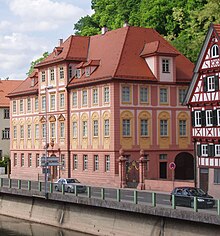Reinhard Fischer (architect)
Reinhard Ferdinand Heinrich Fischer (born June 18, 1746 in Stuttgart , Duchy of Württemberg ; † June 25, 1813 in Stuttgart, Kingdom of Württemberg ) was an important architect of Swabian Classicism , professor of civil engineering , dean of the Faculty of Fine Arts at the High Charles School , Court architect , colonel and chief building director at the court of Duke Carl Eugen von Württemberg .
life and work
Origin and career
Fischer was officially the son of the ducal court chamber councilor and first master chef Friedrich Johann Ernst Fischer and his wife Magdalena Barbara nee. Castenbauer, but was possibly an illegitimate son of the Duke. His younger brother Friedrich Christoph Jonathan Fischer (1750–1797) later became a professor of constitutional and feudal law and a cultural historian.
Fischer attended the Illustrious Gymnasium in Stuttgart, from which the Eberhard-Ludwigs-Gymnasium and the Karls-Gymnasium emerged in 1881 . He then completed training with the sculptor Johann Christoph Friedrich Beyer and from around 1760 with the painter Nicolas Guibal . Philippe de La Guêpière trained him as an architect .
In 1771 he became a teacher at the nursery school , 1773 court architect, 1774 captain, 1775 "professor for civil architecture" at the military academy (the later High Charles School), 1797 major and senior building director. In 1802 he retired.
buildings


Fischer was involved in the construction of the Eberhard Church in Stuttgart's Königstrasse , the New Palace (1807), the Hohenheim Palace , for which he planned an extensive riding facility, the Solitude , the pheasant garden in Weilimdorf and the first Bear Castle (1768) in Stuttgart.
For the 300th anniversary of the University of Tübingen in 1777, Fischer rebuilt the old auditorium , one of the university's oldest buildings.
Furthermore, Fischer was the builder of the early classicist Franziska Church in Birkach , which Carl Eugen gave to Franziska von Hohenheim and the population of Birkach in 1780 . After Carl Eugen's death (1793), Fischer redesigned Kirchheim Castle as a widow's residence for Franziska von Hohenheim.
Fischer's private buildings include the Palais Vischer (1787–1791) and the Reichert House in Calw, as well as numerous, but mostly destroyed, residential buildings in Stuttgart. The house of his brother-in-law, the government councilor Carl Friedrich Feuerlein at Friedrichstrasse 46 in Stuttgart, was also built by Reinhard Fischer, but later had to give way to the building of the Württembergische Vereinsbank founded in 1869, which was destroyed in the Second World War.
family
Fischer married in Stuttgart in 1773 with Juliana Charlotte Bilfinger (* 1753; † after 1806), a daughter of the councilor and court judge Friedrich Ferdinand Bilfinger († 1761) from Stuttgart and his wife Juliane Charlotte Vollmann. The Bilfinger family was widely ramified. The Prussian Legation Councilor Wendel von Bilfinger (1758–1835) became Fischer's brother-in-law and his sister-in-law Christiane Luise Bilfinger married the Prussian ambassador to the Swabian district, Johann Georg von Madeweiss. The marriage of Reinhard Ferdinand Heinrich Fischer and his wife Juliane gave birth to their son Ferdinand and daughters Frierike Luise, Heinrike Franziska and Franziska Juliane.
- Karl Reinhard Ferdinand Fischer (1784–1860), architect, senior building officer, Württemberg personnel nobility since 1841, 1834–1852 professor and director of the Stuttgart Polytechnic
- Charlotte Juliane Franziska (1778–1826)
- ∞ Philipp Friedrich von Hetsch (1758–1838), painter
- ∞ Daniel Friedrich von Volz (* 1764), Württemberg staff nobility 1847, district archivist and pupil counselor
literature

- Hans Koepf : Fischer, Reinhard Ferdinand Heinrich. In: New German Biography (NDB). Volume 5, Duncker & Humblot, Berlin 1961, ISBN 3-428-00186-9 , pp. 203 f. ( Digitized version ).
- Horst Ossenberg: What remains, the builders create. The Württemberg court and state building system from the 15th to the 20th century. Book-on-Demand 2004, ISBN 3-833-40633-X , p. 49ff.
- Gustav Wais : Old Stuttgart: the oldest buildings, views and city plans up to 1800; with urban history, architectural history and art history explanations. Stuttgart 1954, p. 246.
- Oskar Widmann (Ed.): Reinhard Ferdinand Heinrich Fischer 1746–1812. A contribution to the history of Louis XVI in Württemberg. Kohlhammer, Stuttgart 1928.
- EJ Zeller: Stuttgart's private building from 1806 to 1844. Stuttgart 1845–1846, delivery 1, plates 4–5.
Web links
- www.calw.de/Palais-Vischer
- See also detail Family fishing geography Schwaben culture , painter Philipp Friedrich von Hetsch [1]
Individual evidence
- ↑ According to Susanne Dietrich, Liebesgunst. Mätressen in Württemberg , DRW-Verlag 2001, p. 42, Fischer was an illegitimate son of the duke.
- ↑ Horst Ossenberg: What remains, the master builders create. Book-on-Demand 2004, p. 49 f.
- ↑ accessed on April 5, 2009.
- ↑ accessed on April 5, 2009.
- ↑ accessed on April 5, 2009.
- ↑ The story of the sea lane queen. From the old days of Friedrichstrasse - The Pistorius house and the Feuerlein family . In: Stuttgarter Zeitung No. 178 of August 6, 1955, p. 36
- ^ Leopold von Zedlitz-Neukirch : New Preussisches Adels-Lexicon , Volume 1, Leipzig 1836, p. 239.
- ^ Leopold von Zedlitz-Neukirch: New Prussian Adelslexicon , Volume 4, Leipzig 1837, p. 334.
- ↑ https://www2.landesarchiv-bw.de/ofs21/olf/struktur.php?Stock=5599&klassi=& AnzeigeKlassi= 006
| personal data | |
|---|---|
| SURNAME | Fischer, Reinhard |
| ALTERNATIVE NAMES | Fischer, Reinhard Ferdinand Heinrich; Fischer, Reinhard Ferdinand Heinrich (full name) |
| BRIEF DESCRIPTION | German architect |
| DATE OF BIRTH | around June 18, 1746 |
| PLACE OF BIRTH | Stuttgart |
| DATE OF DEATH | June 25, 1813 |
| Place of death | Stuttgart |

